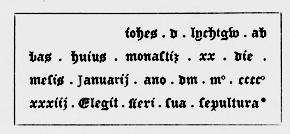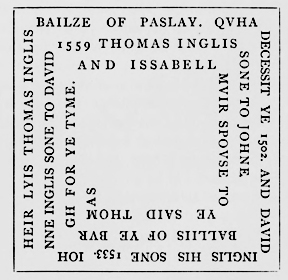Chapter XX: Remains
The transept of the Abbey, and the choir, which had no aisles, are roofless. Two piers of the central tower remain. Whether the tower was built again after its fall in the time of Archbishop Hamilton [12] is uncertain. It is said, in an account of Renfrewshire, supposed to be written previous to 1653, to have “fallen by its own weight, and with it the quire of the church.[13] It is probable that this refers to the fall in Hamilton's time, to which we have referred, and that the Reformation found the monks worshipping in the nave. The massive wall dividing the nave from the choir seems, from its workmanship, to belong to the pre-reformation period. A large bell is said to have hung in the tower, and to have been carried by the English soldiers, in the time of Cromwell, to Durham, and placed in the Cathedral of that city. There is no trace of it to be found there now. [14] The four sedilia at the south-eastern extremity of the choir, and the altar drain and credence niche, mark the spot where the high altar stood, before which, King Robert the III. was buried, and where his remains might probably still be found.
We are only able to conjecture what was the position of the conventual buildings. But after comparing the plan of Wenlock, from which the monks originally came, with that of Crosraguel, which they afterwards erected, we think it is probable that the chapter house, [15] with Saint Mirin's chapel, occupied the east side of the cloister court, the refectory the south side, and the dormitory the west. The Abbot's house probably stood at the south end of what is called Cotton Street. There were buildings also between the Abbey and the river Cart attached to the Monastery, portions of the foundation of which are occasionally uncovered.
The present burying-ground has been used only since the Reformation. The churchyard of the Monastery probably was near Seedhill, where there was an old graveyard some time after the Reformation. [16]
Crosses seem to have been placed at intervals on the roads leading to the church. There is mention in the Abbey charters of two of these erections. The Cross of the Lord, on the other side of the Cart, near the Saucel, and the Cross of St. Mirin on the lands belonging to the Burgh. The names of Corsebar and Corseflat in the neighbourhood seem to indicate that crosses also stood at these places.
There are several monuments and inscriptions of an ancient date in the church. In the porch is the tablet to Abbot Lithgow which we have already noticed.

John of Lychtgow abbot of this monastery made choice of his burial place the xx day of January mccccxxxiii.
In the north aisle is one bearing the following inscription in relief :—

The family of Inglis was well-known at one time in Paisley, and several of them were bailies of the town.
[12] See ante.
[13] Hamilton's Renfrewshire, p. 147.
[14] I have made enquiries, in which I have been assisted by one of the Cathedral clergy. All the Cathedral bells were recast under Dean Comber in 1693, having been previously recast in the same century. None of the present bells have any inscription referring to Paisley.
[15] The supports of the groining of the Chapter House are still visible on the outside of the south wall of St. Mirin's Chapel.
[16] On the 2d April, 1620, “The laich house in the Seedhill, with an auld graveyaird attached thereto, was set for a year to John Greenlees, son natural of Thomas Greenlees, in Blackland Mill, for four pounds (6s. 8d.). Entry to the yaird at once, and to the house at Whitsunday.”